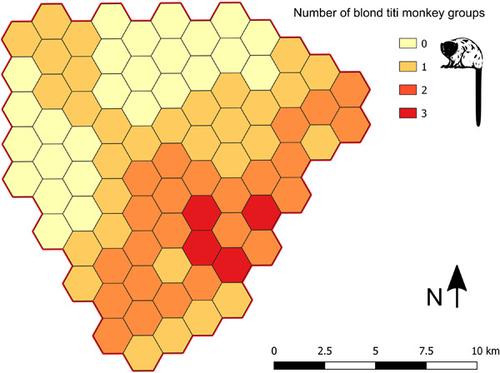当前位置:
X-MOL 学术
›
Am. J. Primatol.
›
论文详情
Our official English website, www.x-mol.net, welcomes your feedback! (Note: you will need to create a separate account there.)
Playback point counts and N-mixture models suggest higher than expected abundance of the critically endangered blond titi monkey in northeastern Brazil.
American Journal of Primatology ( IF 2.4 ) Pub Date : 2020-03-30 , DOI: 10.1002/ajp.23126 Igor P Coelho 1 , Sara J Collins 2 , Eduardo M Santos Júnior 3 , Mônica M Valença-Montenegro 3 , Leandro Jerusalinsky 3 , André C Alonso 3
American Journal of Primatology ( IF 2.4 ) Pub Date : 2020-03-30 , DOI: 10.1002/ajp.23126 Igor P Coelho 1 , Sara J Collins 2 , Eduardo M Santos Júnior 3 , Mônica M Valença-Montenegro 3 , Leandro Jerusalinsky 3 , André C Alonso 3
Affiliation

|
Effective management of threatened species requires accurate population size estimation and monitoring. However, reliable population size estimates are lacking for many endangered species. The critically endangered blond titi monkey (Callicebus barbarabrownae) is an endemic primate of the Caatinga biome in Northeastern Brazil. A previous assessment based on presence-only data estimated a minimum population size of 260 mature individuals in 2,636 km2 , and studies based on visual records suggested very low local relative abundance. However, this cryptic species is known to be difficult to visually detect. We played back recordings of C. barbarabrownae loud calls to count the number of responding groups in 34 sampling sites during 9 consecutive days in a 221-km2 study area. Repeated group counts at sites were used in N-mixture models, which account for imperfect detection, to estimate the number of groups in relation to dry forest area and distance to villages. We estimated a total of 91 groups in the study area. Considering the mean number of adults per group as three, we estimated a population of 273 adult individuals, resulting in a density of 2.3 individuals/km2 in the dry forest habitat. Detection probability was four times higher for surveys conducted between sunrise to midmorning than between midmorning to sunset. We also found that C. barbarabrownae abundance increases with increasing dry forest area and increasing distance to the nearest village, indicating the need to promote dry forest restoration in the Caatinga. As our results suggest a larger population of C. barbarabrownae than had been previously estimated for its entire distribution, our results suggest a need for similar assessments in other areas to reliably estimate the total population size. This study demonstrates how playback surveys coupled with N-mixture models can be used to estimate population sizes of acoustically-responsive primates, and thus contribute to more effective conservation management.
中文翻译:

回放点计数和N混合模型表明,巴西东北部极度濒临灭绝的金发titi猴的丰度高于预期。
有效管理受威胁物种需要准确的种群数量估计和监测。但是,许多濒危物种缺乏可靠的种群规模估计。濒临灭绝的金发山雀猴(Callicebus barbarabrownae)是巴西东北部Caatinga生物群落的特有灵长类动物。先前基于仅存在数据的评估估计,在2636平方公里中至少有260名成熟个体,而基于视觉记录的研究表明,本地相对丰度非常低。然而,已知该隐性物种难以目测。我们回放了C.barbarabrownae大声通话的录音,以计算在一个221平方公里研究区域中连续9天中34个采样点中响应小组的数量。在N-mixture模型中使用了重复的站点组计数,其中考虑了不完善的检测,以估计与干旱森林面积和到村庄的距离有关的组数。我们估计研究区域内共有91个小组。考虑到每组成年成年人的平均数量为三,我们估计人口为273个成年个体,因此在干旱森林栖息地的密度为2.3个/ km2。从日出到中午之间进行的调查的检测概率是早晨到中午之间至日落之间的四倍。我们还发现,随着干旱森林面积的增加和到最近村庄的距离的增加,C.barbarabrownae的丰度增加,这表明需要促进Caatinga的干旱森林恢复。由于我们的结果表明,巴巴拉克鲁维酵母菌的种群数量比以前对其整个分布的估计要多,我们的结果表明需要在其他地区进行类似的评估,以可靠地估算总人口规模。这项研究表明,回放调查与N混合模型相结合可如何用于估计声响应灵长类动物的种群数量,从而有助于更有效的保护管理。
更新日期:2020-03-30
中文翻译:

回放点计数和N混合模型表明,巴西东北部极度濒临灭绝的金发titi猴的丰度高于预期。
有效管理受威胁物种需要准确的种群数量估计和监测。但是,许多濒危物种缺乏可靠的种群规模估计。濒临灭绝的金发山雀猴(Callicebus barbarabrownae)是巴西东北部Caatinga生物群落的特有灵长类动物。先前基于仅存在数据的评估估计,在2636平方公里中至少有260名成熟个体,而基于视觉记录的研究表明,本地相对丰度非常低。然而,已知该隐性物种难以目测。我们回放了C.barbarabrownae大声通话的录音,以计算在一个221平方公里研究区域中连续9天中34个采样点中响应小组的数量。在N-mixture模型中使用了重复的站点组计数,其中考虑了不完善的检测,以估计与干旱森林面积和到村庄的距离有关的组数。我们估计研究区域内共有91个小组。考虑到每组成年成年人的平均数量为三,我们估计人口为273个成年个体,因此在干旱森林栖息地的密度为2.3个/ km2。从日出到中午之间进行的调查的检测概率是早晨到中午之间至日落之间的四倍。我们还发现,随着干旱森林面积的增加和到最近村庄的距离的增加,C.barbarabrownae的丰度增加,这表明需要促进Caatinga的干旱森林恢复。由于我们的结果表明,巴巴拉克鲁维酵母菌的种群数量比以前对其整个分布的估计要多,我们的结果表明需要在其他地区进行类似的评估,以可靠地估算总人口规模。这项研究表明,回放调查与N混合模型相结合可如何用于估计声响应灵长类动物的种群数量,从而有助于更有效的保护管理。



























 京公网安备 11010802027423号
京公网安备 11010802027423号